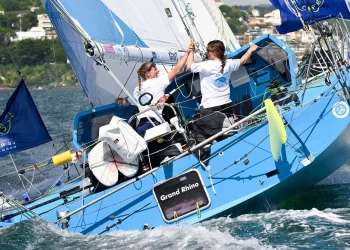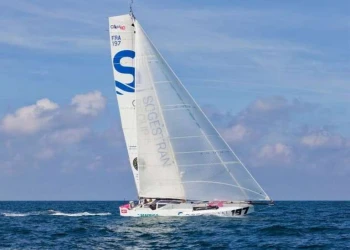
TJV Normandie le Havre, 24 hours that changed the face of the race
TJV Normandie le Havre, 24 hours that changed the face of the race
The whole of the fleet taking part in this 16th Transat Jacques Vabre Normandie le Havre is now at sea. The rapid appearance of two storms that NW Europe experienced, led the race organisers to come up various solutions in a very short space of time.
On Sunday 29th October, plans for the start of the Transat Jacques Vabre Normandie were hrown into disarray. Early that morning, the organisers came to the conclusion that they would have to take the hardest decision imaginable: leaving the IMOCAs moored up in Le Havre, while sending off the Ocean Fifty and Class40 boats to shelter in Lorient. The reason was the arrival of a low-pressure system, which looked exceptional, but had not yet been given the name of Ciaran. This was no time for a rushed decision or improvisation, but the result of a lot of thought and analysis. We look back at 24 hours that changed the face of the race.
On Saturday 28th October in Le Havre, celebrations continued. The Village was marking the end of ten days of festivities and the following morning, everyone was looking forward to the magnificent sight of 95 boats in Seine Bay. However, at Race HQ, faces tensed up. A low-pressure system was deepening in the Atlantic. The most experienced knew already that conditions would be hellish.
Saturday: getting the Class40s to shelter
It had not yet been given a name, but people were already talking about it: Ciaran. On Saturday morning, the Race Directors took a first measure that was announced at the skippers' briefing. The Class40s would set off as planned, but would have to have a stopover in Lorient. For Antoine Robin, co-director of the Transat Jacques Vabre Normandie Le Havre, they needed to be protected and the homogeneity of the race needed to be preserved. "Rather than say everyone could find somewhere to shelter for themselves, we preferred to take a responsible decision and that was to place everyone in shelter on the same footing."
This allowed the slowest class in the race to get out of the English Channel and not find themselves cut off from the rest of the competitors in the transatlantic race. "By sending them to Lorient," explained Francis Le Goff, Race Director, "we helped them save time and we were able to maintain the DNA of the race : 4 classes racing at the same time."
But later in the evening, the weather charts had changed again. The organisers realised that the low-pressure system was developing still further and moving in faster than forecast. Fewer and fewer boats would manage to dive down to the South of Portugal before the arrival of Ciaran and another Low that was behind it (Domingos). At that point, the idea of sending all the boats out was still on the cards, but under one condition: the possibility of getting everyone to shelter on the Atlantic coast.
Saturday night: maintaining a group start and looking for berths for everyone.
Right up until the last moment, Francis Le Goff and his team tried to find alternative solutions. There were some places still free in Lorient for the six Ocean Fifty boats, but it was more complicated for the forty IMOCAs. "We called up various harbours and others we knew had a certain capacity," explained Francis. "We got in touch with Roscoff, but they didn't have much room. I contacted Port-la-Forêt who had three places for the foilers and six for the others... We soon realised that we wouldn't find any places for half of the IMOCAs". So what was the alternative? Separate the IMOCA fleet? "That would have been even worse," said Francis. "Who should set sail? Who should stay behind? And how could we get them off all together again at a start?"
At that point, the Race Directors were still hoping and praying for a break in the weather. "Just like the sailors, we always tell ourselves to wait for the next chart. Right until the end, we hoped we would be able to send them off, find a way out. There was just that smallest glimmer of hope".
Sunday morning: protecting the fleet whatever the cost
Before dawn, the latest charts unfortunately confirmed the worst. We could forget the race aspect. It was a matter of safety first. We needed everyone to get far away from the storm. "There was no longer any choice," admitted Antoine Robin, "this required an emergency measure. The ULTIMs could get through ahead of the front, so we could send them off. The Ocean Fifty and Class40 boats could be sent to shelter in Lorient and the IMOCAs would stay behind in Le Havre."
Securing the boats and waiting....
Once the Class40 and Ocean Fifty boats had left, the IMOCAs had the whole of the Paul Vatine Dock to themselves. The catways were removed and the monohulls moored up more tightly along the side of the docks, facing the wind.
When the storm arrived, many skippers and shore teams remained aboard the boats to keep an eye on them. 60-knot gusts, an extra metre of tide... the photos and videos made by the teams say it all.
In Lorient too, while no major damage was reported, the boats were blown around a bit. But the main thing was that the fleet had been preserved. An impossible choice for the organisers, but this was the wisest decision, when you see 207km/h recorded at the Pointe du Raz at the tip of Brittany.
What if...
We all know that with "if", we could change the world. Legitimate questions were raised on the pontoons and in the corridors. Now that the race was underway and looking back, we can look at the various alternative scenarios on offer.
Why not keep the ULTIMs in port like all the others?
On the day of the storm, the Eure Dock, where the ULTIMs were moored, became a giant jacuzzi. This scenario would have been catastrophic had they stayed there.
Why not let the IMOCAs take part in the parade on the Sunday of the start?
To enter or leave the Eure Dock, you have to go through a harbour gate, which opens depending on a timetable. For 40 IMOCAs, it would take 4 passages through the lock. Dealing with the return of all these monohulls, while the Race Directors were busy with 55 boats at sea in a very rough English Channel, would have been complicated. Moreover, this would have taken place in strengthening winds at nightfall and with a lot of shipping movement around Le Havre.
Hasn't the principle of 4 courses for 4 classes been thrown into question?
Certainly not! With different courses of various lengths according to the class, this has in the case of the postponement, offered flexibility that other direct transatlantic races do not have. Because there was the possibility of shortening the courses, the gap is narrowed at the same time between the winners in each class at the finish in Martinique, to a few days instead of around ten. Having four courses that can be adapted maintains the concept of cohesion and homogeneity between the classes.
The race is now back on, with battles raging for a place on the podium in each class. See you next week in Martinique to celebrate the performance of these incredible double-handed crews.







